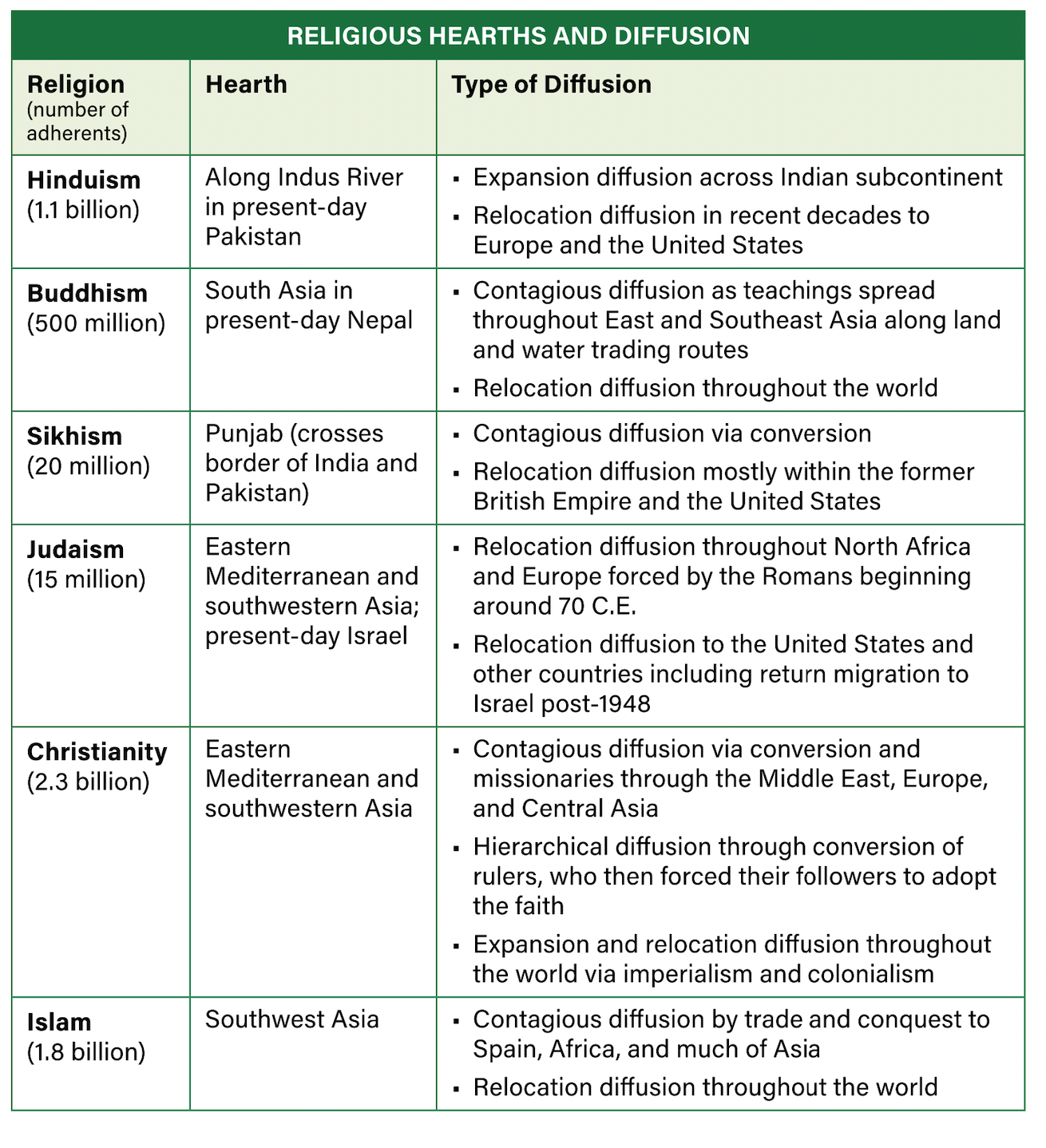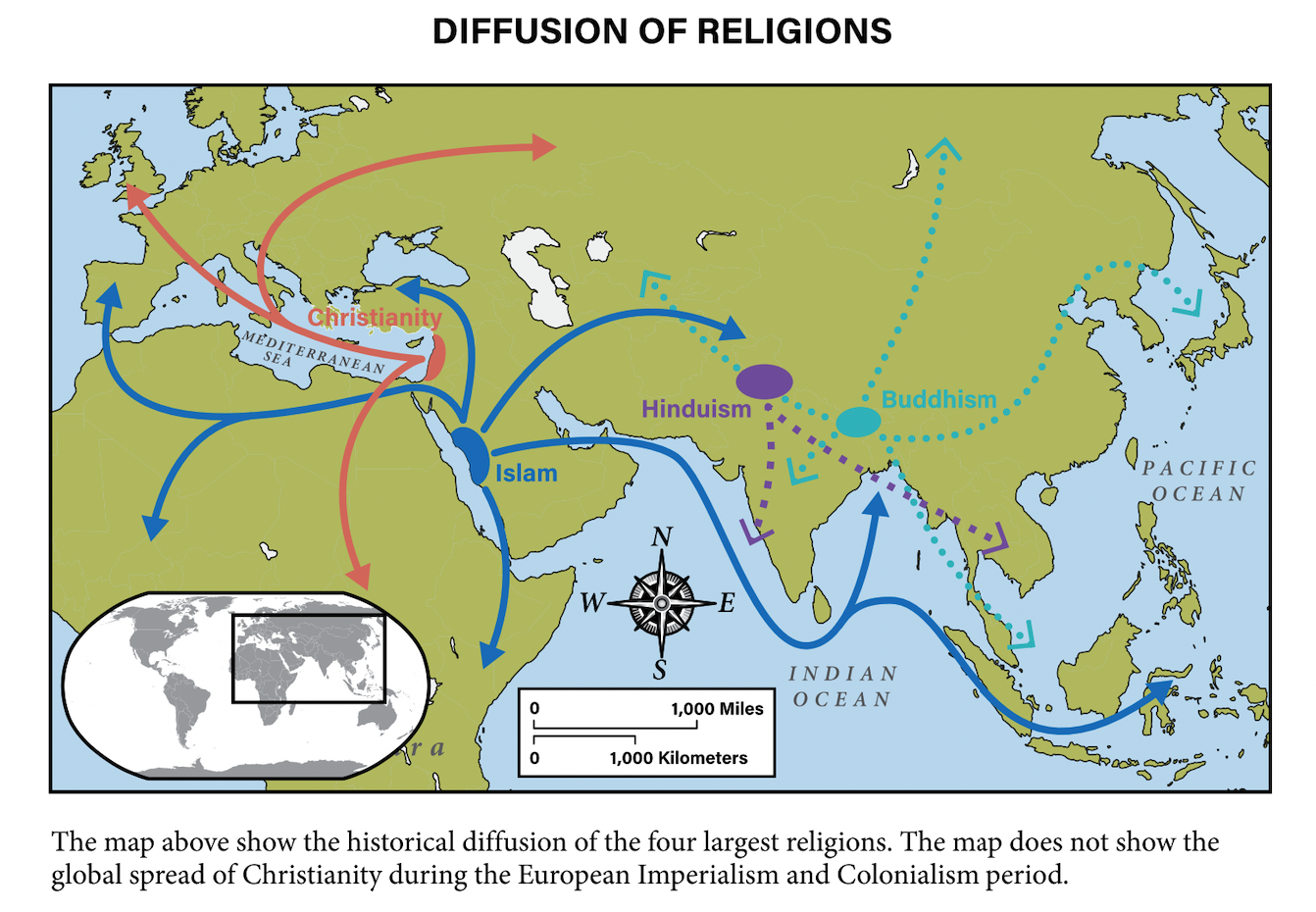Languages
proto-language
language family
language groups
dialect
isogloss
Religion
Universalizing Religions
Christianity
Islam
Buddhism
Sikhism
Ethnic Religions
Hinduism
Judaism

The Navajo, a Native American group of the Southwest United States, face many of the same problems as indigenous people across the world-the loss of their native language and culture in the context of globalization. Currently there are approximately 7,000 languages that people around the world speak. But by the end of the century, about half of those languages will be gone. Most of the languages are spoken by small, isolated groups. As these groups become integrated into the larger society, the people often learn the language of the majority. The traditional language falls into disuse and becomes extinct. Since
language is the key element in communication, with this loss of the language comes a loss of a central part of a group’s history, ethnicity, and cultural identity.
Relationships Among Languages
As the Navajo example illustrates, language is essential to a groups culture. It creates a sense of place and a cultural landscape. The Navajos’ experience shows that today’s communication technologies are reshaping cultures and bringing drastic changes to languages. Some of these changes can contribute to
destroying age-old practices and languages. Yet language, like all elements of culture, has always been hanging. The earliest languages spread from their culture hearths and faced a multitude of local, international, and global forces. These global forces include conquest, colonialism, imperialism, trade, and the widespread instant communication of the present day.
Origins of Language
Currently, linguists, scientists who study languages, have differing theories as to when humans first began communicating through spoken sounds. Some claim first communication began as recently as tens of thousands of years ago to as long ago as a few hundred thousand years. They are also unsure how
language diffused:
- Was it through the dispersion of people, who carried language with them as they spread across the planet?
- Was it through transmission, as people learned language from their neighbors?
- Was it through conquest, with one people imposing language on others?
Language Families
Linguists also are uncertain whether all languages descended from one original language. They do agree that nearly all of the languages spoken today can be grouped into about 15 language families. The relationship among these language families is often shown on a language tree because it suggests how several languages are related to each other, as well as how one language grows out of another.
The distribution of languages reflects human migrations. For example, the migration of Huns from central Asia to central Europe around 1,500 years ago explains why the languages most like Hungarian are found nearly 3,000 miles east of Hungary.
Indo-European Languages
One of the 15 major language families is the Indo-European language family, a large group of languages that might have descended from a language spoken around 6,000 years ago. Nearly half of the world’s population speaks one of the languages of the Indo-European language family. This family includes about
2.8 billion native speakers of between 400 and 500 languages.
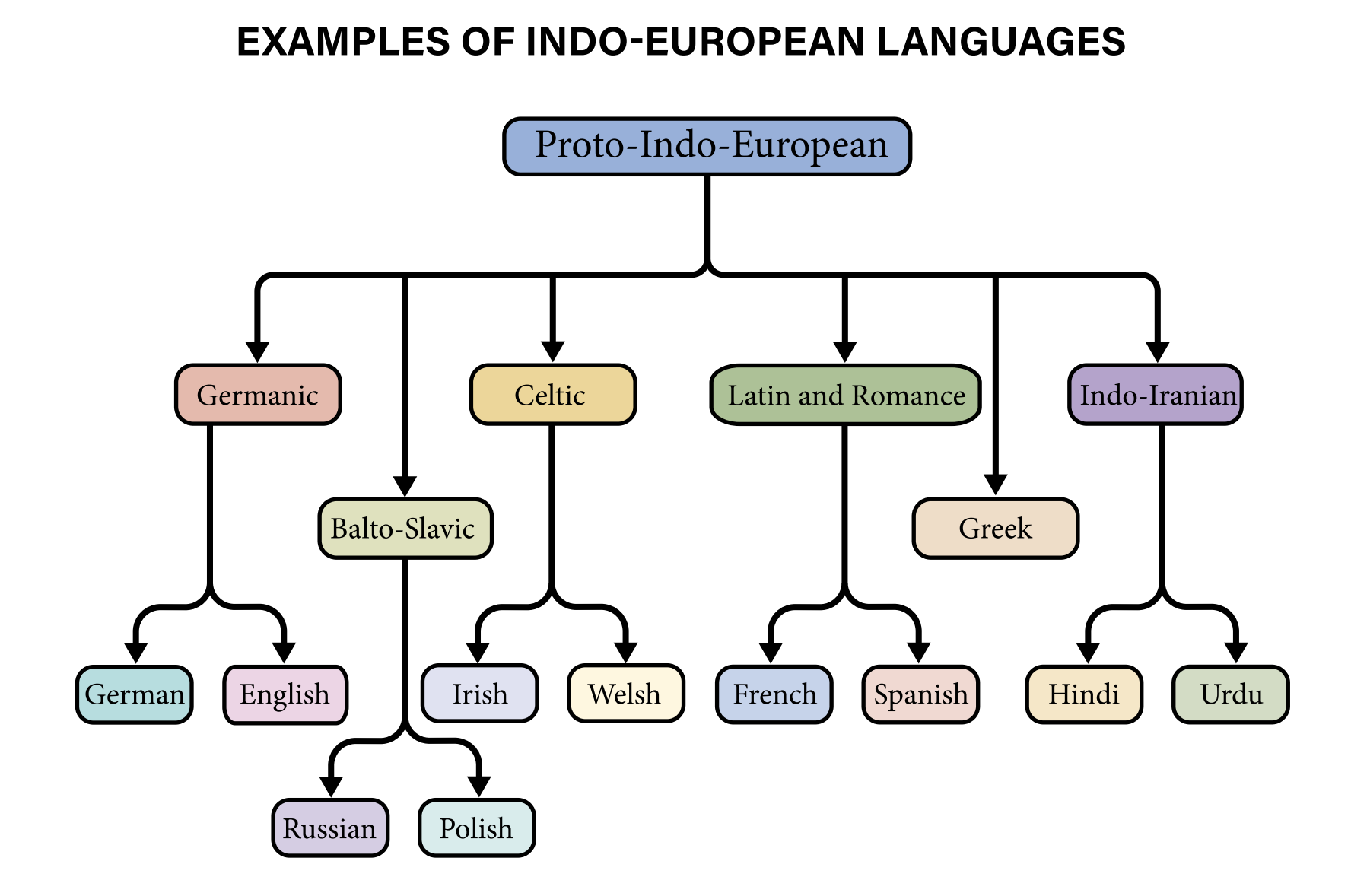
One of the branches of the Indo-European language tree is Latin, and its history shows the difficulties in the study of language. Languages are challenging to study because they constantly evolve as people move away from the languages’ cultural hearths, have contact with other languages, or are
isolated from other languages.
Two thousand years ago, when the Roman Empire dominated much of what is present-day Europe, people there spoke Latin. However, as the empire dissolved, starting in the 5′ century, transportation became more dangerous and trade declined. As a result, Latin speakers became geographically isolated from each other. The unifying language of Latin diverged into dozens of distinct regional languages, known as Romance languages. Most of these later vanished, but Portuguese, Spanish, French, Italian, and Romanian, among others survived and grew. The historical connection among these languages is evident in their similar words.
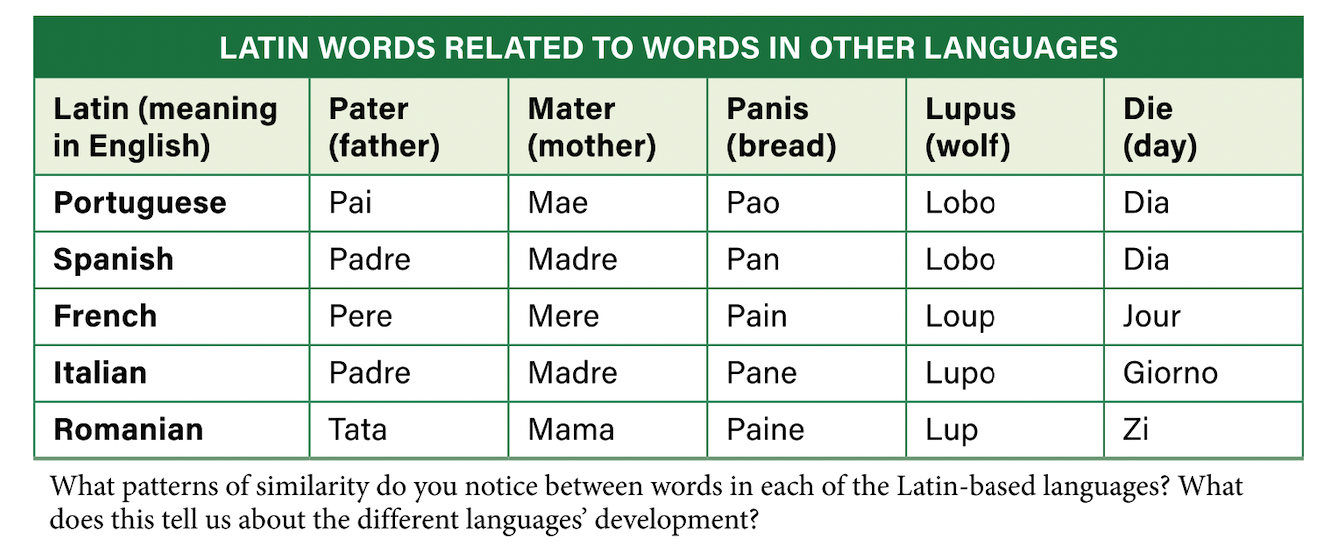
Note that English words such as father and mother are similar to Latin words, but words such as bread and wolf are not. This suggests that English is not a direct descendant of Latin. English evolved from a Germanic language but has been heavily influenced by Romance languages such as French.
Accents and Dialects
Languages can be further divided into smaller categories by other traits. One is by accent, how words sound when pronounced. Accents often reflect social class or geographic region. The boundaries between variations in pronunciations or word usage are called isoglosses. For example, as you move from east to west in Texas, the term “dry creek bed” used near Dallas is replaced by the Spanish word “arroyo.” This isogloss represents the boundary between southern dialect and a Texan variation.
Variations in accent, grammar, usage, and spelling create dialects, or regional variations of a language. Variations between dialects are large enough that most speakers notice them, but small enough that speakers can understand each other easily. Often, the dialect spoken by the most influential group in a
country is considered the standard, and others are modifications of it. “Hello, everyone” is standard. “Hi, yall’ and “Hi, you guys” are dialectical variations.
Dialects often include distinct adages, or sayings that attempt to express a truth about life, such as “the early bird gets the worm.? Additionally, dialects are geographic and create formal regions of a country or the world. Within dialects are sub-dialects. For example, in the United States, a native of Texas is likely to
speak a different dialect than a native of New York City.
Often, dialects are the legacy of differences in the past, but they can also be a first step in the evolution of a new language. Just as the Romance languages emerged as regional variations of Latin, new languages are developing today. For example, if the differences between British English and American English increased so much that speakers could not easily communicate with each other, the two would be classified as different languages instead of dialects of one.
The following chart shows differences between two dialects of English American and British.

Language Policies and Cultural Landscape
Language is important to a group’s cultural identity. Because a culture occupies a certain spatial area, its language becomes intertwined with that place and its landscape. For example, native Hawaiians, whose economy relies on fishing have five dozen words for fishing nets. In addition, signs can create a cultural
landscape as they reflect the people’s linguistic heritage and tie them to that place-from the single-language signs in France to bilingual signs in places such as Belgium, Quebec, or Wales.
Official Languages
While the United States does not have an official language, one designated by law to be the language of government, some countries do. These countries can be grouped into three categories:
- Some countries are homogeneous, or made up largely of ethnically
similar people, such as in Iceland, Japan, or Slovenia. - Some countries use language to discourage people from maintaining a
traditional culture. English colonizers did this in Ireland, Scotland, and
Wales to promote quick assimilation. - Some countries include several large ethnic groups. These countries want
to honor all groups equally. For example, Zimbabwe is home to several
large ethnic groups, so it has 16 official languages. People use English as
a lingua franca to make communication easier.
English is the most common official language in the world with 64 countries, followed by French (32), Arabic (27), Spanish (23), and Portuguese (10). Official language does not necessarily mean the most spoken language in a country.
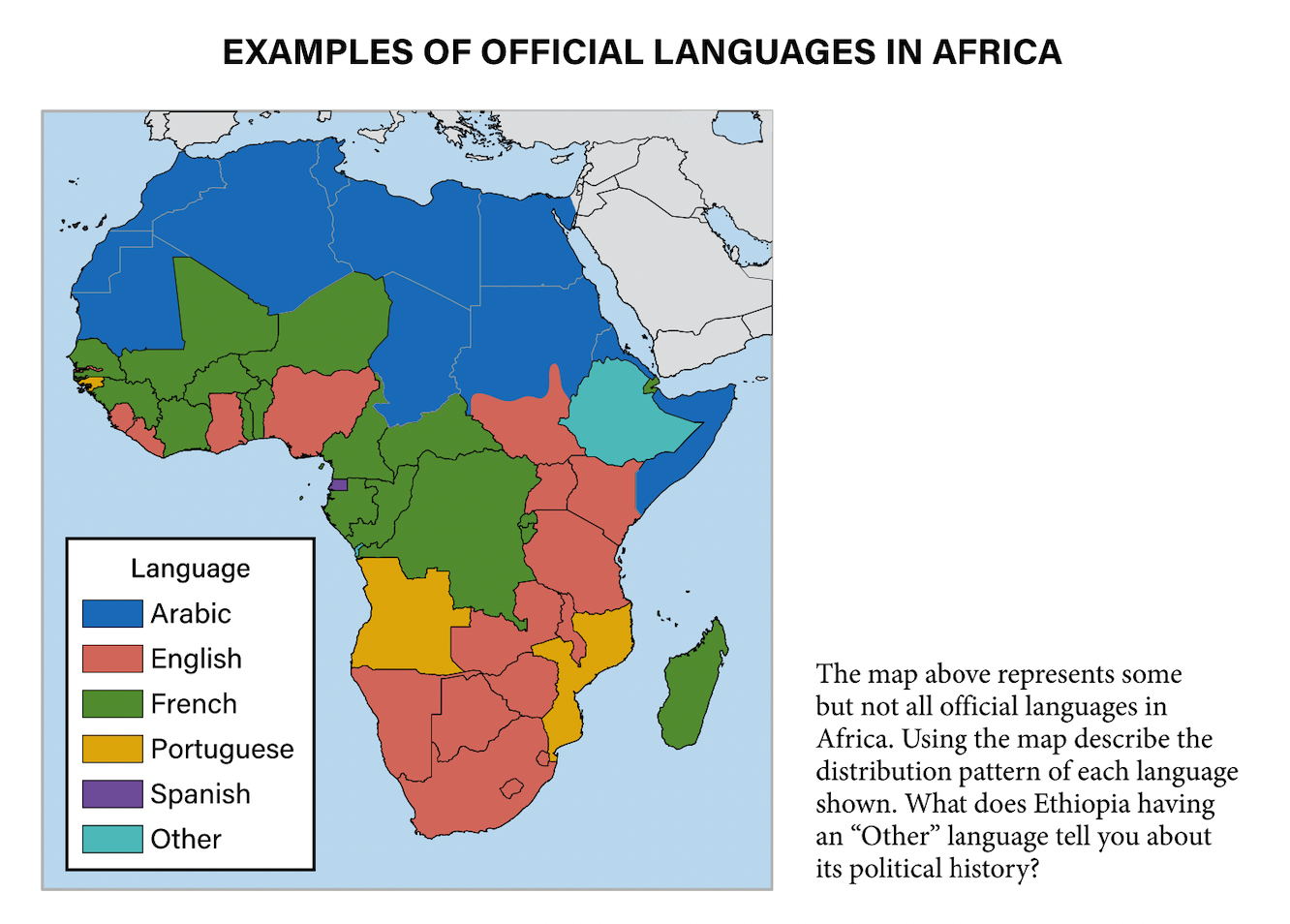
Ethnic and Universalizing Religious
Religion is intertwined with all other aspects of history and geography because, compared to other aspects of culture, it is relatively resistant to decay over time and distance. For example, descendants of immigrants often adopt a new language but continue to practice the faith of their ancestors and remain
adherents, or believers in their faith. Developing strong mental maps of the origins, diffusion, and distribution of major religions and their divisions is one of the most valuable ways to understand culture.
Ethnic religions are belief traditions that emphasize strong cultural characteristics among their followers. In most cases, adherents of an ethnic religion are born or adopted into it. Members have a shared historical
experience or struggle that creates strong bonds. Ethnic religions rarely recruit new followers actively. Rather, they spread as a result of relocation diffusion Hinduism and Judaism are the world’s two most widespread ethnic religions. The Jewish Diaspora and global migration of Hindus from India are examples
of such relocation diffusion.
In contrast to an ethnic religion, a universal religion actively seeks converts to its faith regardless of their ethnic backgrounds. Universalizing religions are open to all people regardless of their ethnicity, language, social status or nationality. The major universalizing religions of the world are Christianity, Islam, and Buddhism. Sikhism is also considered universalizing but has a much more limited geographic diffusion. Universalizing religions have spread far from their original hearths because existing members feel a mandate to spread their beliefs to others. To carry out this mandate, members of universalizing religions often serve as missionaries who both perform charitable works and convert non-believers.
Eastern Religions
Several belief systems have developed in Asia. Of these, two developed in India and have diffused to other places from there. Hinduism Classified as an ethnic religion, Hinduism includes the worship of many deities, so most scholars consider it polytheistic, which means having many gods. However, Hindus consider all deities as manifestations of one god so it can be considered monotheistic, which means having one god.
Hindus believe in karma-the idea that behaviors have consequences in the present life or a future life-and in dharma-which means the righteous path. For part of its history, Hinduism worked closely with a caste system, a rigid class structure, that shaped Indian society. The concept of reincarnation or rebirth based on the quality of life a person lived is a central belief of most Hindus. A soul would spiritually advance enough to become liberated from this cycle of death and rebirth. Rivers are considered sacred and symbolic of life and purification of sin.
Buddhism
Buddhism grew out of the teachings of a prince named Siddhartha who lived around 600 B.C.E. Accepting many beliefs of Hinduism but rejecting the caste system, Siddhartha became known as the Buddha, or “enlightened one”. According to Buddhist traditions, Siddhartha had been meditating for several days underneath a bodhi tree when he finally understood the cause of suffering and how to end it. Buddhist doctrines became summarized in the Four Noble Truths, which sought to eliminate desire and suffering by following the Eightfold Path. Siddhartha advised followers to escape the cycle of suffering through “right” views, hopes, speech, conduct, livelihood, effort, mindfulness, and meditation. This path requires an individual to meditate, reflect, and refrain from excessive earthly pleasures. The goal is, over time, to achieve enlightenment and the peaceful bliss known as nirvana, which would end the cycle of reincarnation.
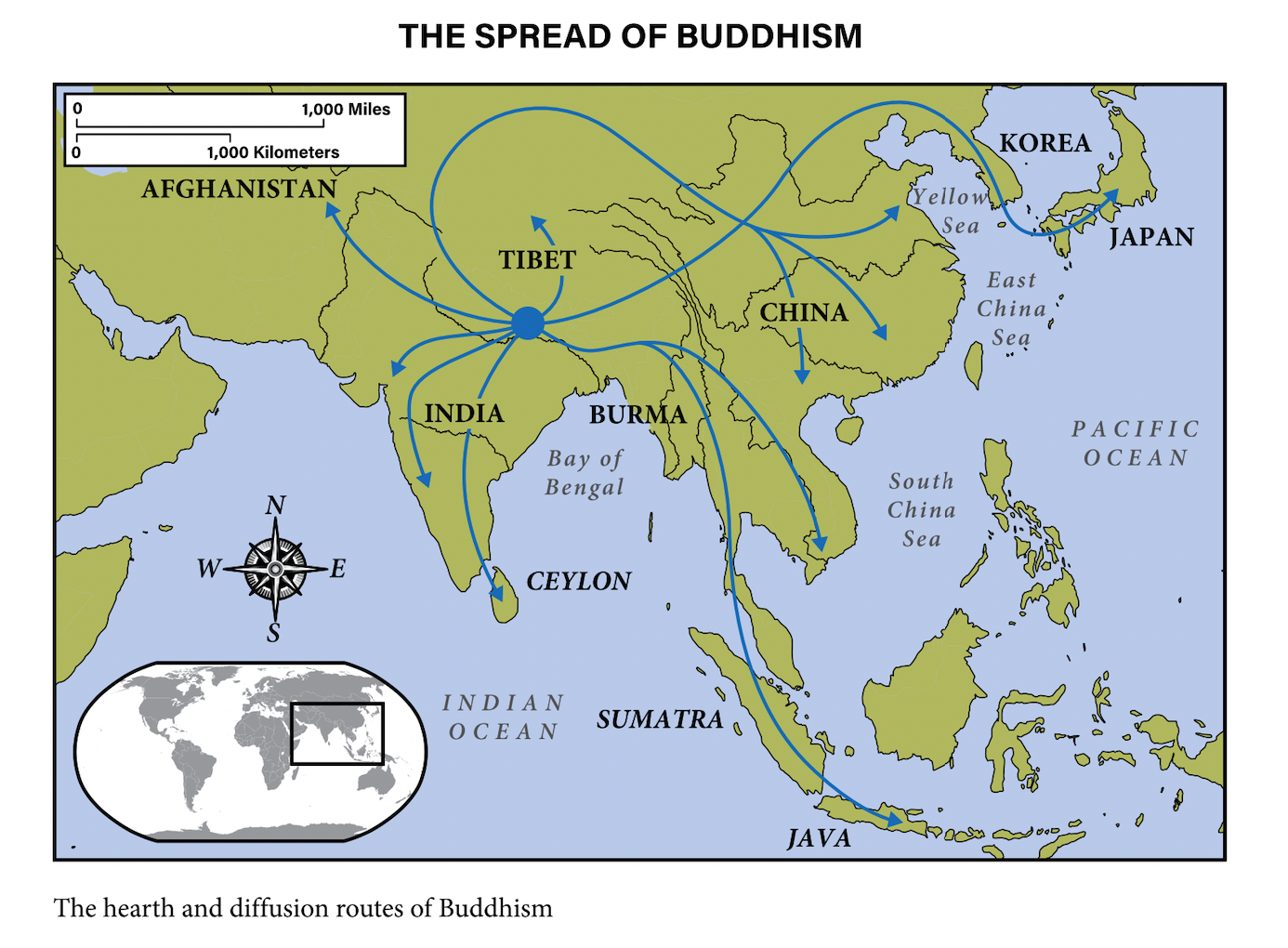
Sikhism
A relatively new universalizing monotheistic faith, Sikhism was founded by Guru Nanak in the Punjab region that crosses the border of India and Pakistan during the 16′ century. Most Sikhs live on the Indian side of the border and enjoy more religious freedom than those of other religions in the area. The faith stresses serving others, honesty, hard work, and generosity rather than rituals. All men who are baptized add the name Singh (lion) and women add the name Kaur (princess). This practice was adopted to break down
the influence of family names and the caste system in India in order to create a more equal society. A Sikh’s place of worship is called a gurdwara and followers usually attend a service once a week. All gurdwaras have a worship gathering space and contain a food kitchen that serves meals to people of all faiths. The most holy place is the Golden Temple in Amritsar, India.
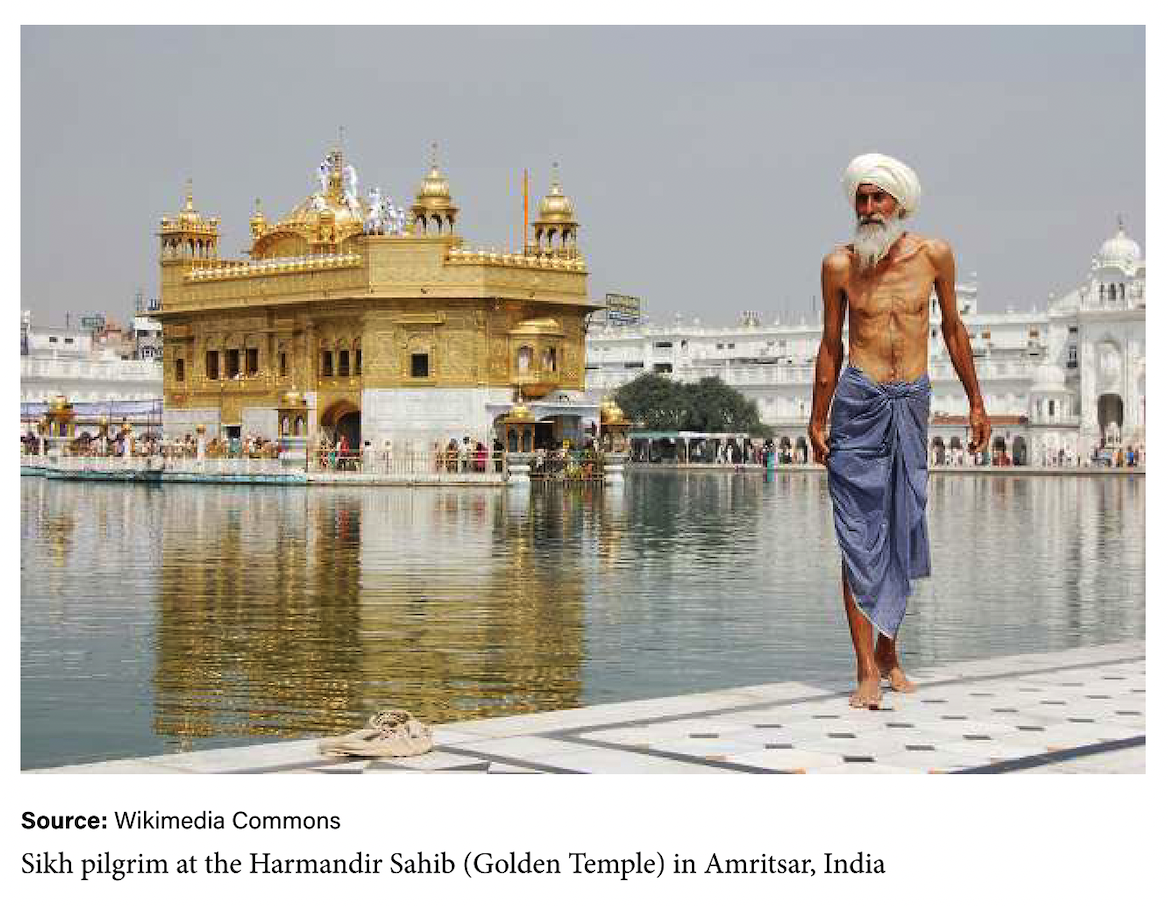
Middle Eastern Religions
Three major religions trace their history to Abraham. He was a religious leader who lived in the Middle East around 1800 B.C.E. Judaism Judaism was among the first monotheistic faiths. Jews believe that the writing known as the Torah expresses divine will. It is supplemented by other writings as well as unwritten laws and customs. For the past 2,000 years, most Jews lived in Europe and North Africa. Always a small minority, they often suffered persecution. In the late 1800s, Jews searching for religious liberty began efforts to establish a homeland in the Middle East and began their migration to the United States. During World War Il, the systematic murder of six million Jews by Nazi Germany, an event known as the Holocaust strengthened the movement to create a predominantly Jewish state in the Middle East. In 1948, the country of Israel was formed. Jews from around the world migrated there.
Christianity
Christianity began when followers of a Jewish teacher, Jesus (c. 4 B.C.E. to c. 30 C.E.), evolved into their own religion based on the belief that Jesus was the son of God and the savior of humans. He emphasized the importance of faith, love, and peace. Christianity spread outward from the Middle East to become the dominant religion in Europe, and then to America and other parts of the world. There are three main branches of Christianity–Roman Catholic, Protestant and Eastern Orthodox-with hundreds of further subdivisions. Strong patterns associated with language help to explain in part the geographic distribution of both religion and language. Many Catholics trace their heritage or colonial history to regions that spoke Romance languages such as French, Spanish, or Portuguese. Protestants often have a similar history with northern European and Germanic languages like English. And many Eastern European countries have a complex religious history related to a mix of Eastern Orthodox, Judaism, and Islam. While Christianity diffused primarily west, north, and east from its hearth in Israel, in one unique case it diffused south. In Ethiopia, Christianity attracted many adherents.
Islam
Islam is the religion followed by Muslims. Muslims believe that Allah- the Arabic word for God-revealed his teachings to humans through a series of prophets. The last of these was Muhammad, who lived in what is now Saudi Arabia in the 6th and 7th centuries C.E. Muslims believe that Allah communicated his teachings to Muhammad who shared them with people in the book of holy writings known as the Quran The core principles of the Quran became known as the Five Pillars of Islam:
- declaration of faith: belief in one god-Allah
- ritual prayer 5 times a day
- almsgiving (giving of wealth or volunteering for charitable causes)
- ritual fasting (abstaining from food or drink)
- pilgrimage to Mecca
Muslims evolved a law code based on the Quran, called sharia, to regulate religious and civic behavior. Sharia made no distinction between religious and civil law and countries that operate under it are considered theocracies.
The two major subdivisions of Islam are the Sunni (90 percent of adherents) and Shia (10 percent of adherents). Countries with the highest Shia populations are Iran, India, Pakistan, Iraq, Yemen, and other countries in the Middle East and Africa.
Diffusion and Pilgrimage
The two largest universalizing religions are Christianity and Islam. Each spread from their hearths partially through conquest and colonization. Christianity, which was found mostly in Europe in the 15th century, added millions of followers when Christian missionaries accompanied European explorers and conquerors to the Western Hemisphere, southern Africa, and Australia. As Europeans expanded their empires, they converted people to Christianity, sometimes forcefully.
Islam spread in much the same way, through the Middle East, North Africa, and Asia. Today, Islam is the fastest growing religion in the world based on natural increase. In many faith traditions, followers feel called to go on a pilgrimage, a religious journey taken by a person to a sacred place of his or her religion. Each year, over 20 million Hindus journey to the Ganges River, millions of Muslims travel to Mecca (a pilgrimage known as a hajj), and many Muslims, Jews, and Christians visit Jerusalem’s many holy sites.
